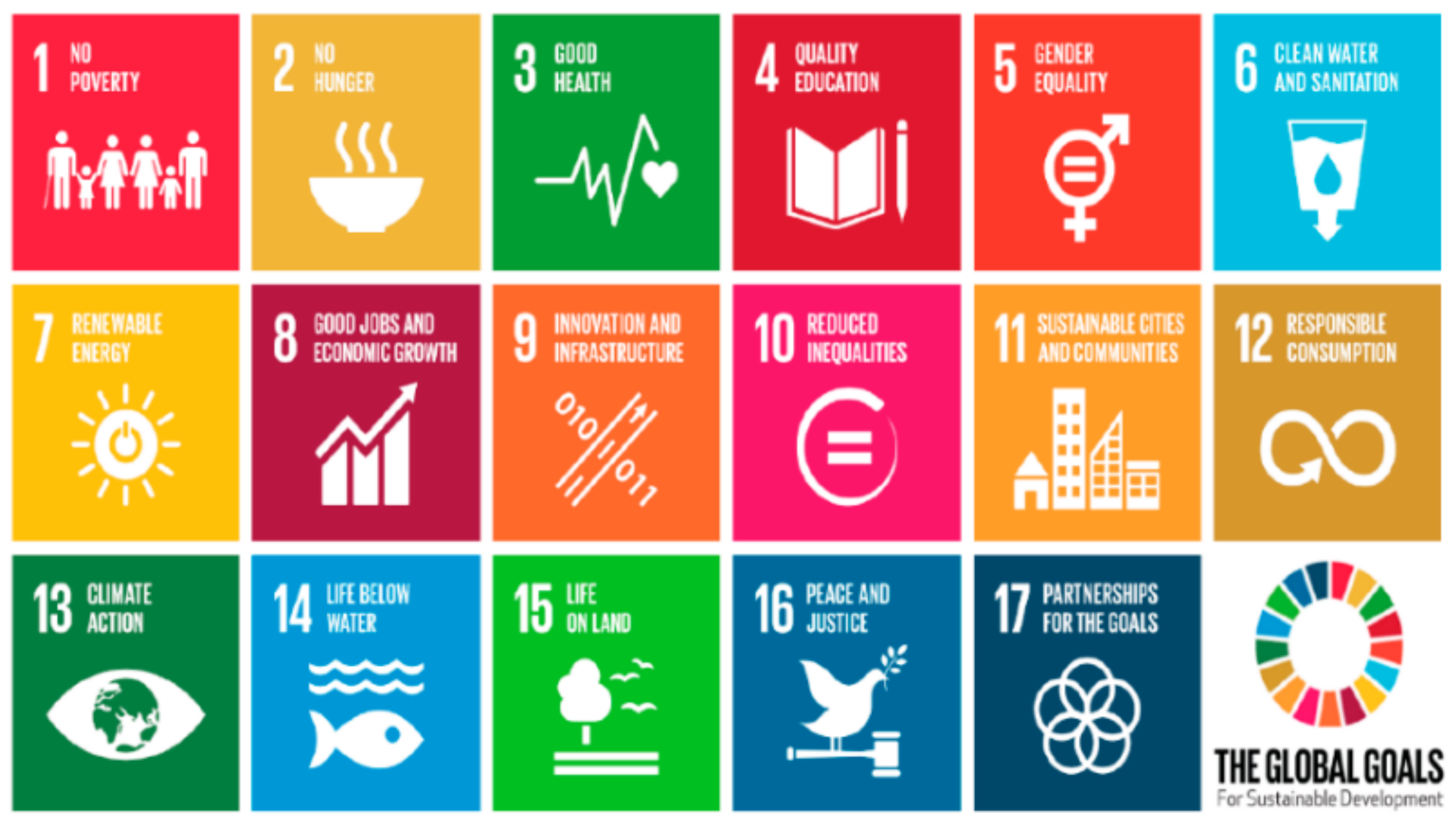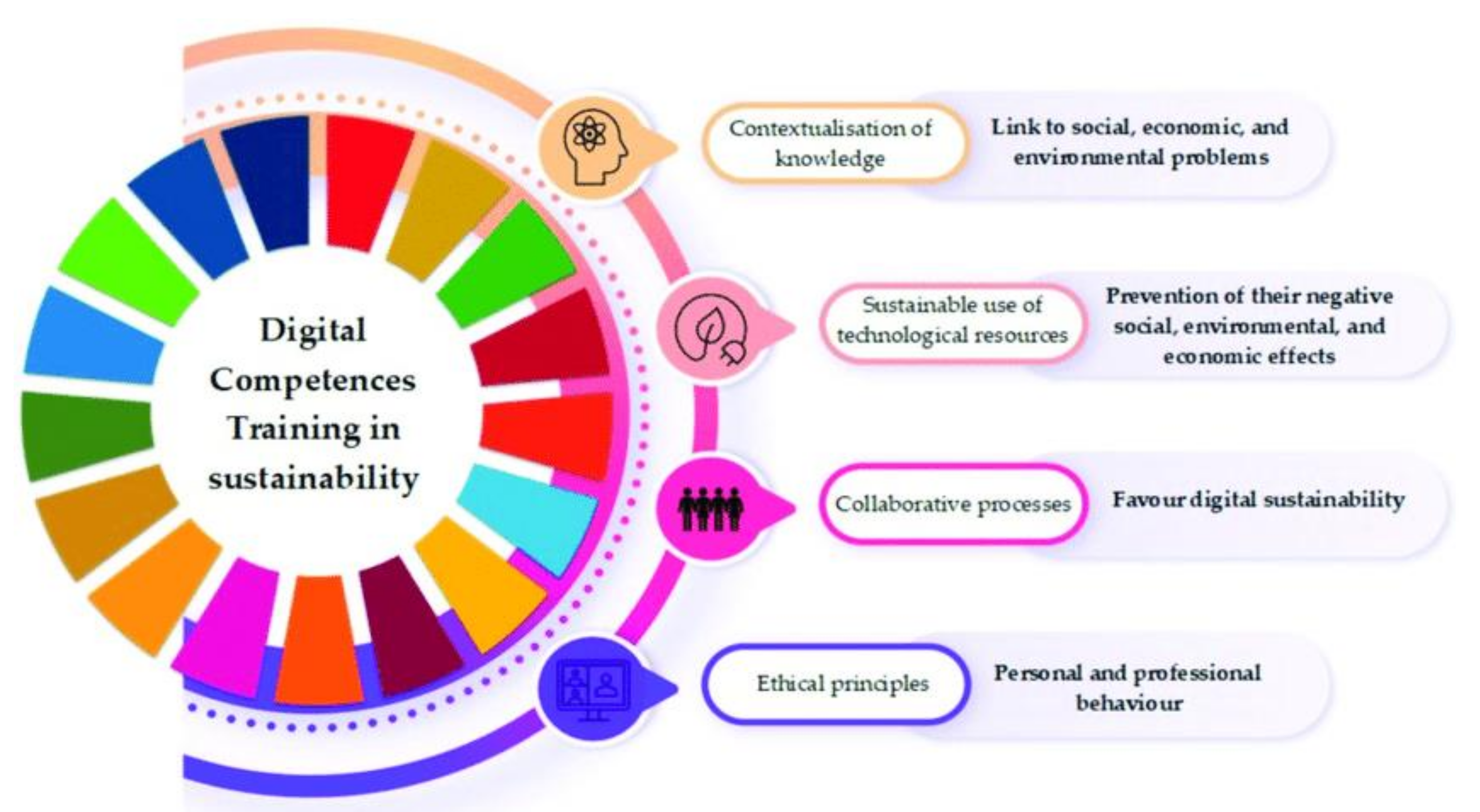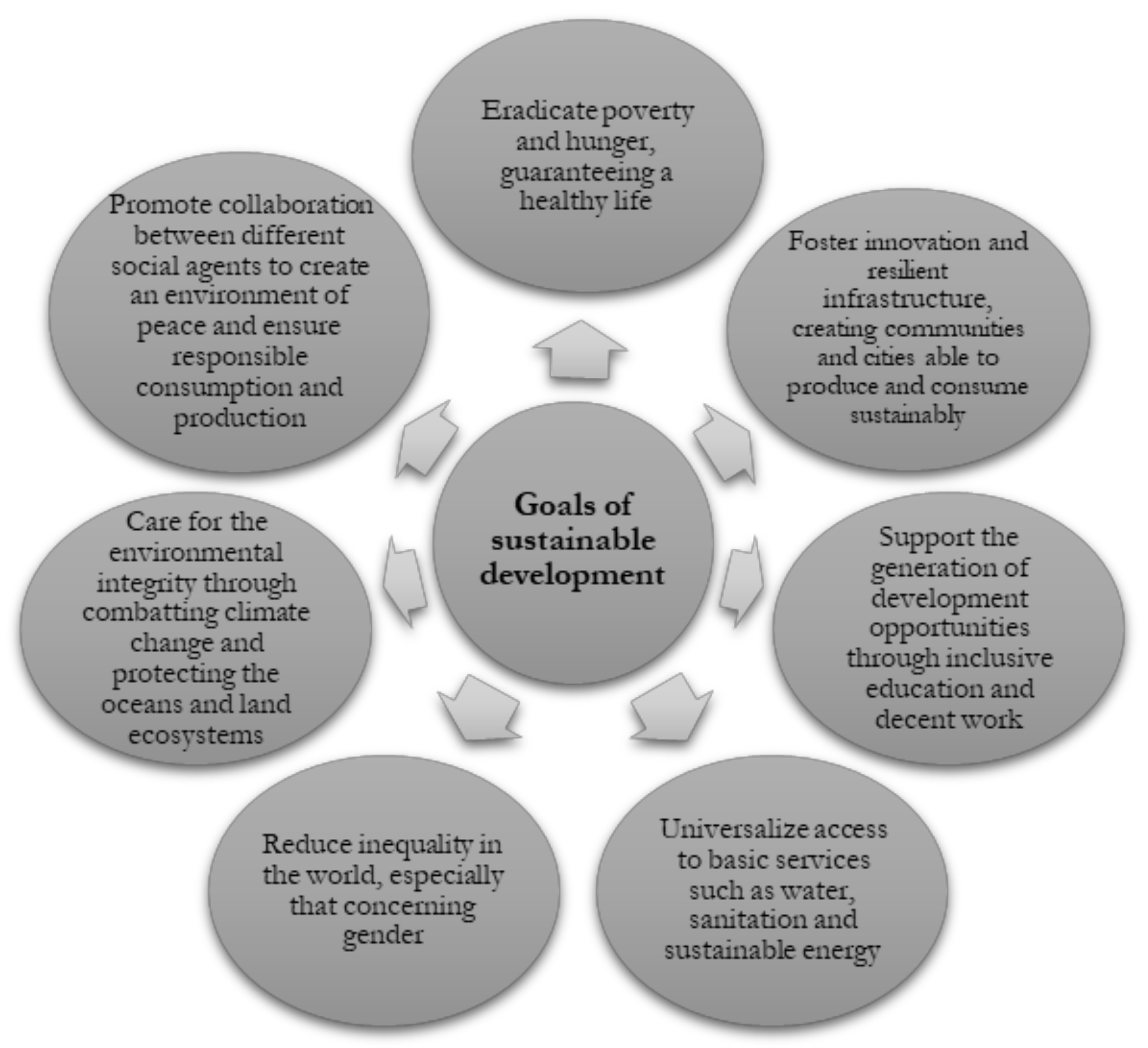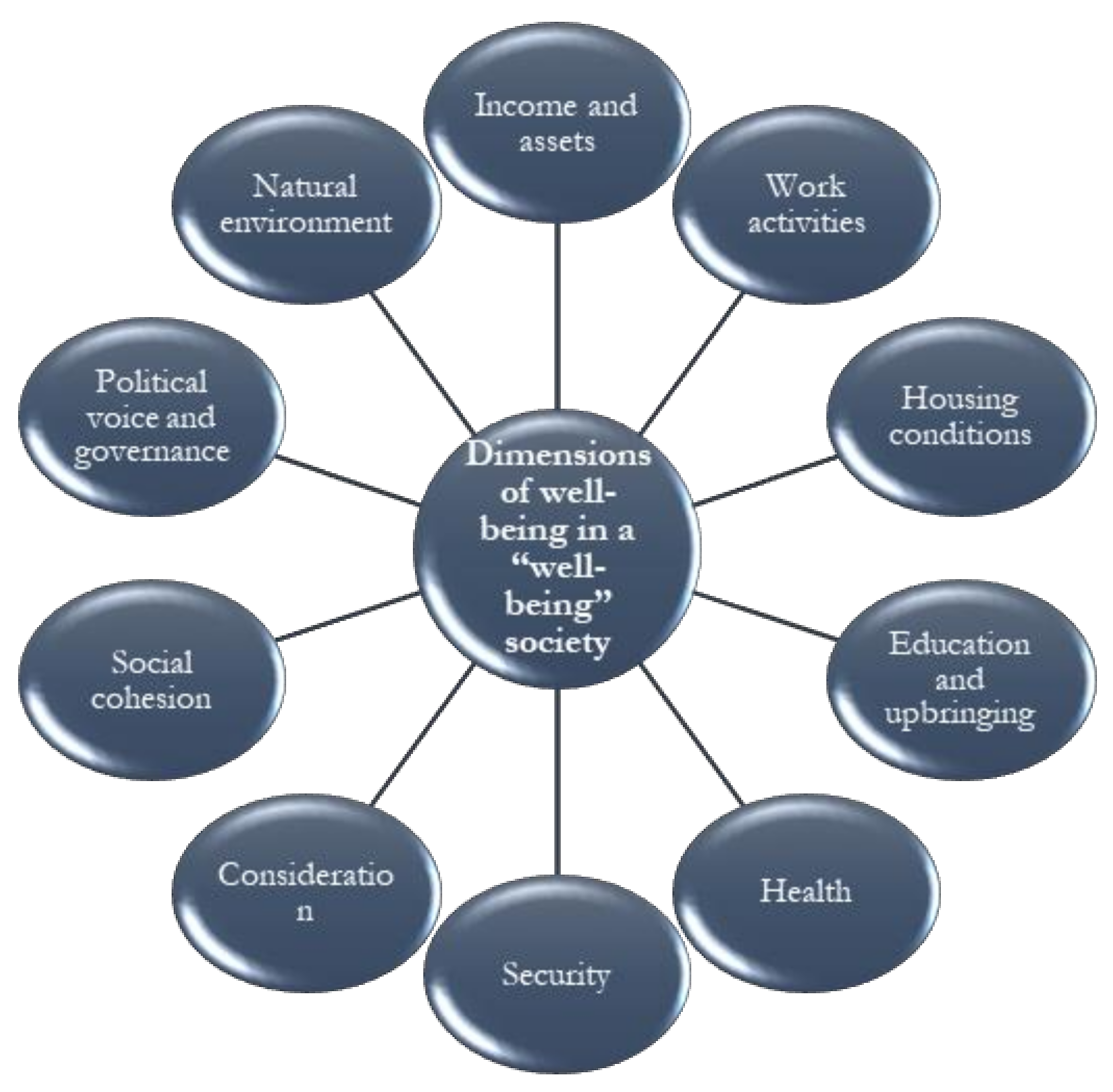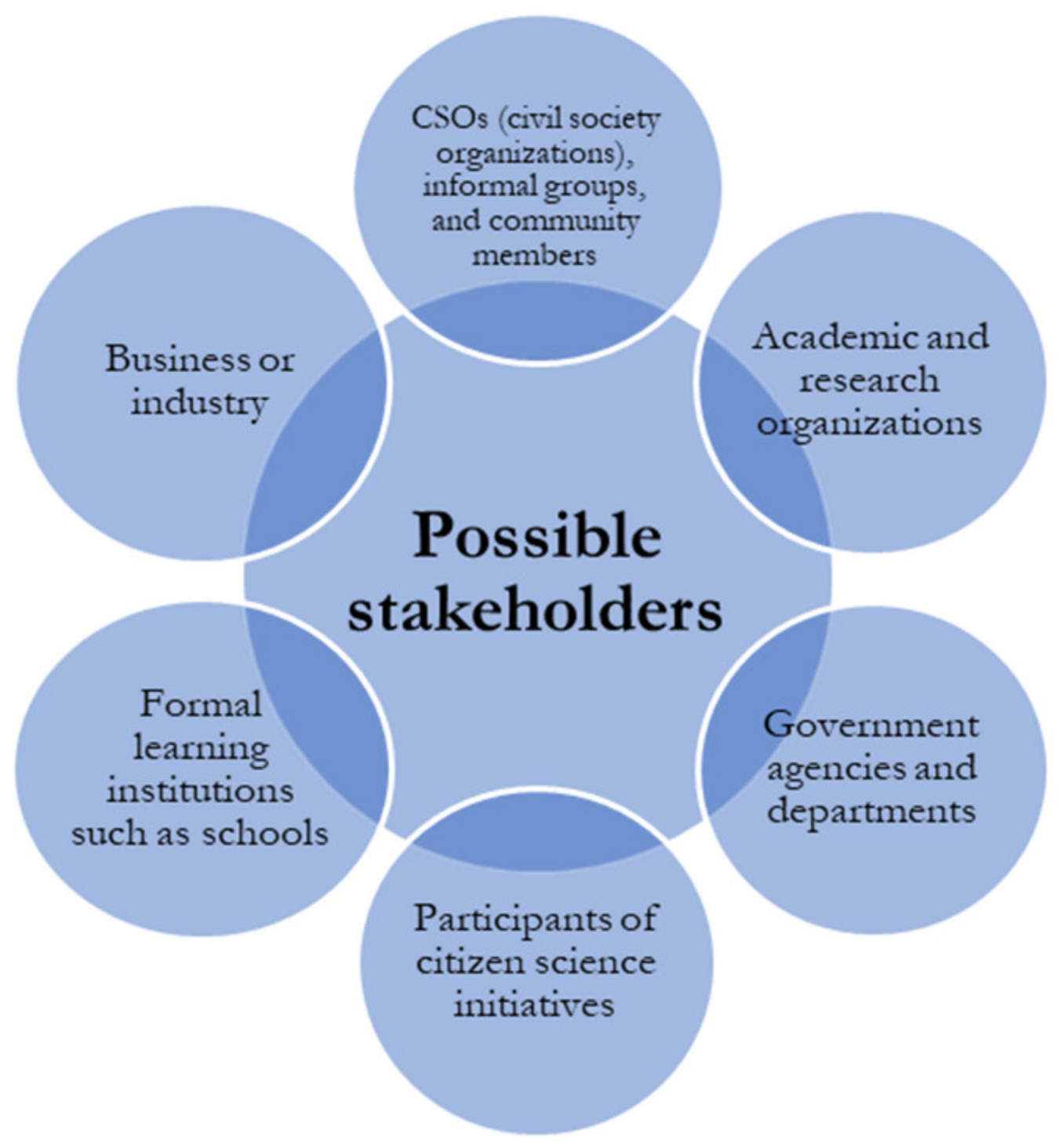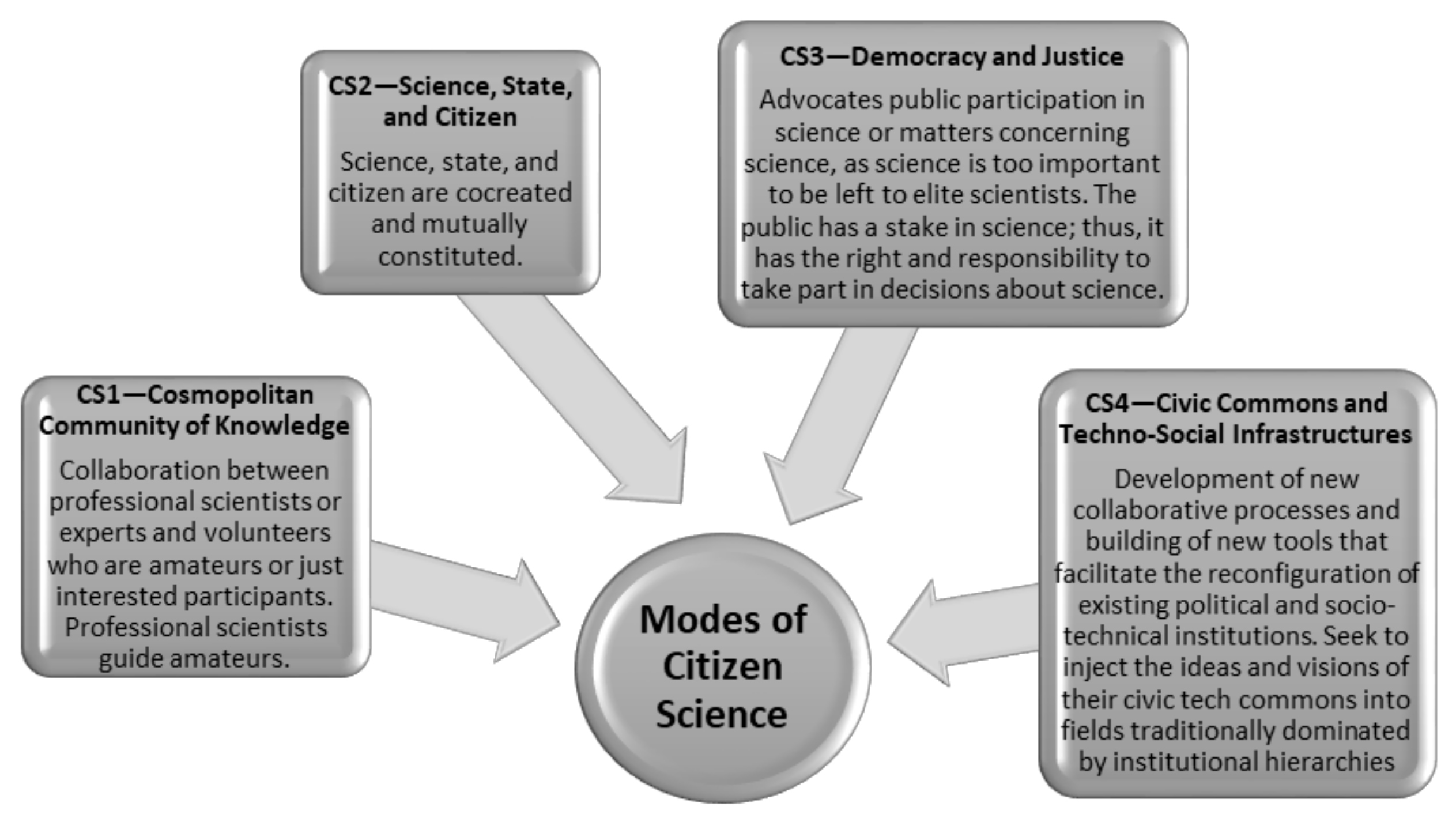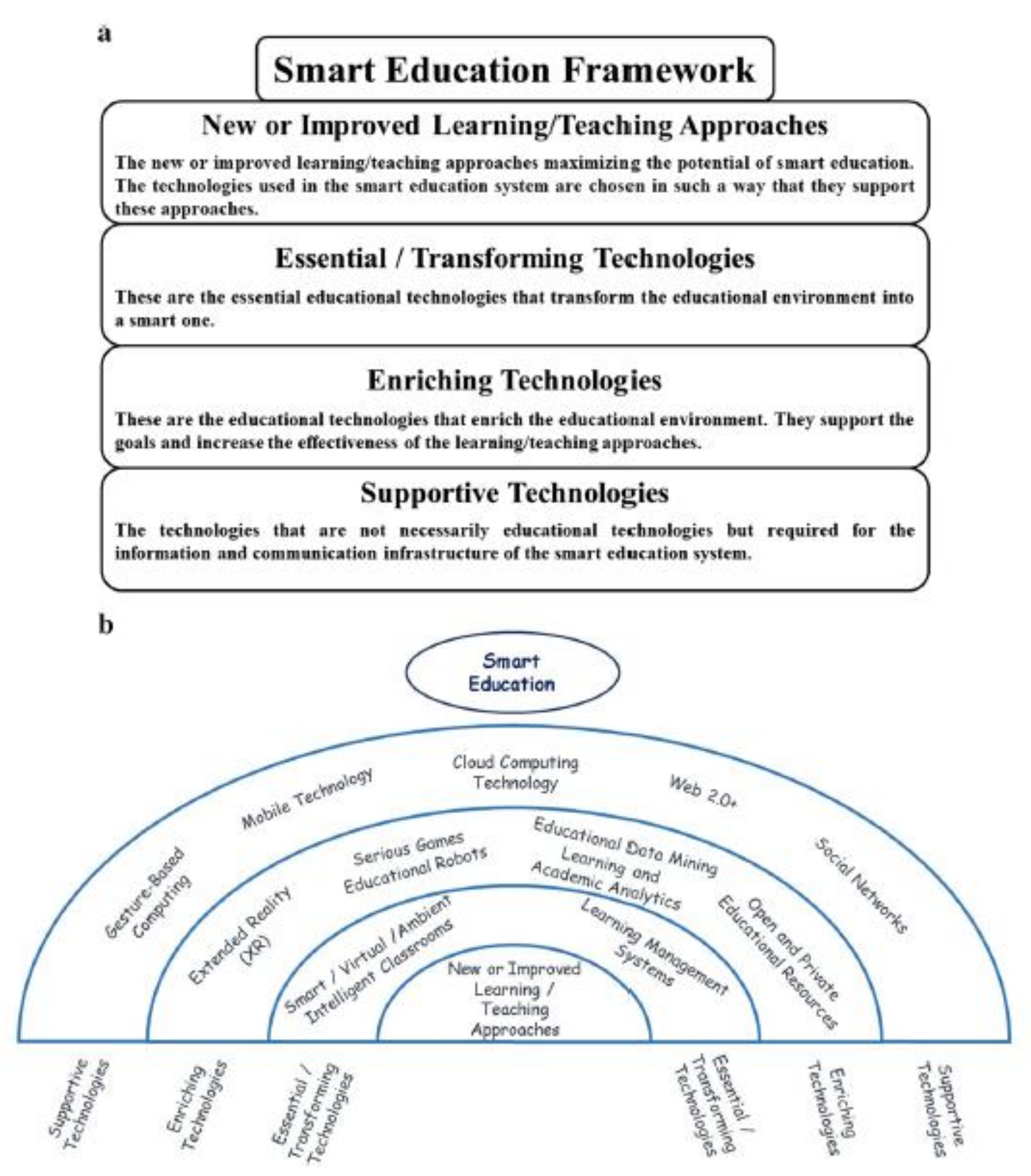3. Society 5.0
We live in an increasingly digital society, with many challenges emerging from this [
1,
21,
22].
Society 5.0 embodies the transformations brought about by this digital society. It is a recent concept with an essentially political origin. This concept emerged in Japan as a super-smart society, and its purpose, articulating the virtual with the real world, is human and social development in fostering quality of life and economic growth with cohesion and social justice while respecting sustainability [
1,
8,
21,
22,
23,
24,
25,
26,
27,
28,
29].
Society 5.0 is the most recent stage of human development. Before it, very briefly, Society 1.0 was characterized by groups of humans who hunted to survive and lived in a totally balanced way with nature; Society 2.0 began when groups started to develop agriculture, social organization and the formation of nations; Society 3.0 corresponds to the Industrial Revolution, with the emergence of industrialization and mass production; Society 4.0 introduced the concept of an information society through global connection and worldwide information networks. It led to a digital transformation of the information society, allowing the emergence of Society 5.0, which is, thus, the continuation and corollary of Society 4.0, but characterized by being human-centered. The big difference between these two societies is that, while Society 4.0 focuses on the reduction of costs and effective production techniques in industry, Society 5.0 focuses on society as a whole and is a human-centered society [
28,
30,
31].
The world we live in is in permanent change, and the technological development we have been witnessing over the last decades is fast, constant and with profound influences on the lives of citizens. In this dynamic scenario, Society 5.0 has, as one of its main purposes, to place the individual as the epicenter of the choices that are made at various levels (e.g., social-, cultural- or economic-level decisions, among several others). Thus, the increase of social sustainability must take into account the establishment and development of a more inclusive society, in which digitalization should be put at the service of humanity [
32] with a logic according to which no individual is left behind [
21].
The core concept of the Society 5.0 model is the large-scale collection and garnering of real-time data from all sectors of society, and its fundamental purpose is to make the most of the technological transformation for the benefit of all its citizens, namely in problem-solving processes [
21]. In this way, and according to this model, the individual is placed at the center of the various choices, from social to economic and cultural. Consequently, this model of society aims to build a more inclusive society in which digitalization is placed at the service of the individual to achieve so-called social sustainability. In this sense, technological innovation can and should be used to improve the functioning of societies in their various fields [
32].
Having originated, as already mentioned, in Japan, Society 5.0 has been expanding on a planetary scale in the building of digital societies [
24,
26], having at its base a rather interesting paradox, which involves the establishment of a society in which the epicenter is the human being, implying their interaction with the most-diverse forms of artificial intelligence at the service of human beings, namely social robots and entities equipped with artificial intelligence, which are no longer passive agents that only execute the instructions they receive from humans but, rather, entities with learning, decision-making and autonomy abilities [
23].
This Society 5.0, as a “system of systems” of interconnected elements linked to each other, with the mobilization of information and big data, and to and from the Internet in a digital way [
25], has five principles to include all individuals, presented in
Table 2.
To achieve the intended goals and to ensure that this type of society is not controlled by large companies, it is critical to foster the effective participation of all [
23,
25,
33]. This raises deeply complex challenges, not only in technical terms—of digitization—but also in terms of use by ordinary citizens [
23,
34], which implies “digitability”, which the next section addresses.
4. Digitainability
Following Colás-Bravo, Conde-Jiménez and Reyes-de-Cózar [
35], sustainability regards those actions that aim at enhancing contemporary societies’ well-being in economic, social and educational terms while safeguarding future generations’ living standards.
Table 3 depicts the four sustainability areas that educational sustainability should cover.
The 2030 17 SDGs (
Figure 1) seek to achieve the development sustainability process by articulating human/social, economic and environmental development [
36,
37], respecting the past, present and future in harmony between society and nature [
12].
Digitalization and digital transformation are pivotal for the 2030 Agenda goals to be attained and, thus, also for the accomplishment of most SDGs [
3].
Digital transformation may be defined, according to Jummai [
38], as all the changes that take place at all levels of any organization—regardless of its type—in terms of its culture and ways of functioning, through the adoption of digital technologies, processes and competences that foster the organization’s development and enhancement.
The Internet plays a pivotal role in these changes, not only at the organizational level but also in terms of individuals’ daily life. It allows people to interact with each other, to be permanently connected with the world, to know what is happening at the global level in real-time—in sum, to be socially linked to everything and everyone that surrounds them [
11].
However, even with all the technological advances the world has experience over the last decades, there are still distinct levels of digital access and use, which the International Communications Union calls (i) the digital access gap, regarding those who are able to and those who are not able to utilize ICT (Information and Communication Technologies); (ii) the digital gap of use, which regards the competences and abilities to use ICT; and (iii) the quality-of-use gap, concerning the different ways in which different people use ICT [
39].
Regarding the last dimension (the quality-of-use gap), it has to do with digital literacy, defined as
[…] the individual’s ability to identify in a digital environment and encompass basic knowledge, skills, and abilities related to digital hygiene, digital ethics, communication, technical and consumer security, the Internet of Things, XR, basics of data processing and analysis, as well as basic computer and Internet skills in the modern digital environment.
In addition, the ability of individuals to show that they master the digital—that is, that they have digital literacy, both as consumers and as producers of digital artefacts—is critical for sustainable development [
40]. This focus on the digital has produced a new term, “digitainability”, which brings together “digitization” and “sustainability” and reflects the links between sustainability and digitalization [
3].
Education is one of the most relevant arenas for digitalization, and it depends on digital processes for its advancement. One of these advancements is digital doubles, which consist of a digital model of an object (e.g., a part of the educational process) that “[…] repeats what is implemented by its existing prototype and also allows one to study the functioning of the latter” [
12] (p. 6). Education has already started to and will experience major shifts as early as this century, namely in terms of the traditional teaching and learning processes and methods. Computerization, digitalization and the transition to sustainable development (SD) are at the heart of these shifts, the main purpose of which is to ensure that the way in which the contemporary generation is developed does not hamper the wellbeing of future generations [
12]. The training of digital competences within the sustainability paradigm entails four fundamental dimensions: (i) the contextualization of knowledge, which regards the teaching of critical thinking skills that allow students to learn to reflect on the social, cultural and disciplinary conditions in which knowledge is produced; (ii) the sustainable use of technological resources, which implies the use of technologies in an eco-responsible way; (iii) collaborative processes that favor digital sustainability; and (iv) the respect for ethical principles [
41,
42] (
Figure 2).
Thus, one of the main purposes and goals of sustainable digital education is to prepare today’s individuals to commit themselves to be part of a responsible and sustainable social transformation and, in this way, to pave the way of sustainability for future generations [
3,
43,
44].
These concerns underlying sustainable digital education are, naturally, in line with SGDs and, particularly, SDG#4 (quality education) [
3], which occurs both inside and outside the educational system [
35].
5. Digitalization and Sustainability
Currently, sustainability, in its multiple dimensions—social, economic and ecological, among others—is paramount. We are also living in unsustainability, having exceeded the limits of reasonability to have a successful future [
45,
46], with digitalization having the potential to create new consumption patterns [
21].
This digitalization and the presence of the Internet entail profound changes in society. The developments brought about by digital transformation involve changes in terms of the quality of technologies, but also—and as a consequence—important changes at the level of social configurations. According to Meshcheryakova and Rogotneva [
47] (p. 175), these changes and their direction are defined by four innovative technologies: “cloud computing, big data, artificial intelligence and the Internet of Things”.
Digital literacy, as “access, consumption and production of digital forms” [
1] (p. 4), in an intentional way is critical in this process of reducing the digital divide due to several cultural, economic and social factors of this (new) reality that shapes Society 5.0, as it is pivotal for the critical and conscious participation of the actors in the promotion of sustainable development [
1].
As a way to ensure the attainment of a set of social priorities on a global scale, the United Nations (UN) approved, through its 2030 Agenda, a set of 17 Sustainable Development Goals (SDGs), whose fundamental goals are to protect the planet, eradicate poverty and to ensure the well-being of populations [
48].
Table 4 presents the 17 SDGs defined by the UN.
Achieving these SDGs—which have been adopted by 193 countries, came into force in January 2016 and aim to stimulate economic growth, ensure social inclusion and protect the environment—means achieving the outcomes shown in
Figure 3.
Albeit the implementation of this Society 5.0 model brings a wide range of advantages, it also has several drawbacks, which
Table 5 accounts for.
Even with the existence of some disadvantages, the implementation of the Society 5.0 model is envisaged as an important step towards improving people’s living conditions and achieving sustainable development.
Hence, alongside all the advantages of developing Society 5.0 also come shortcomings, and this concept has raised serious reservations about the democracy upon which it is supposed to be based by some of its critics. McMillan Cottom [
49] (p. 443), for example, states that
[…] To both expand and exclude, the platform-mediated era of capitalism that grew from Internet technologies specializes in predatory inclusion [which regards] including marginalized consumer-citizens into ostensibly democratizing mobility schemes on extractive terms.
McLaren [
24] (pp. 567, 582 and 595) also offers a very pertinent critical position on Society 5.0 and casts doubt on the true intentions and consequences for individuals and societies of implementing the Society 5.0 model, arguing that
While Society 5.0 seeks its solutions through further abstracting humanity from the natural world it is destroying, locking us in a deterministic bubble, Ecological Civilization seeks to re-embed us in nature, repair our dysfunctional relationships with it and promote freedom through transcendence to higher levels of development. […] Society 5.0 is a surveillance society, one with a scale of projected electronic monitoring of human behaviour never before seen in our history. […] Society 5.0, therefore, like surveillance capitalism more generally, is designed to stunt human development creating a population of compliant, comfortable idiots.
In turn, Žižek, Mulej and Potočnik [
50] (p. 11) speak of Society 6.0, proposing a “Sustainable Socially Responsible Society 6.0”, while upgrading Society 5.0 by the application of a Sustainable Socially Responsible Society 6.0 model, materializing a “Well-being Society 6.0”.
Figure 4 graphically presents what Žižek et al. [
50] consider to be the 10 basic dimensions of well-being in a welfare society.
The overall well-being of citizens thus involves synergy—in the sense of a collective and simultaneous effort—between the various types of well-being: material, social and environmental [
50]. The authors argue that this Society 6.0 must obey a set of postulates that should be put into practice by all organizations, whatever their type (
Table 6).
The authors put forth what they call the output of Well-being Society 6.0, which encompasses three core dimensions: (1) Sustainable social responsibility, in personal, corporate and societal terms; (2) SSR behavior, requiring personally accountable citizens; and (3) Sustainable leadership leaders [
50] (p. 16).
Moreover, building a sustainable global society and finding solutions to its crises and challenges requires, more than resorting to technological solutions, changing and correcting individual behaviors, defining public policies that shape the sustainable society, and a combined, global effort to address the complexity inherent in the social relationships and structures that shape history [
51].
6. Society 5.0 and Citizen Science
For Society 5.0 to become a reality on a global scale, it is critical that societies promote social dialogue, explore technologies and foster the participation of all at all levels. Society 5.0 has as one of its central assumptions, as already mentioned, the active participation of all in social issues, i.e., it must ensure that all citizens have access to the same opportunities in the logic of full participation mediated by innovative technologies. This is the basis for sustainable development [
29].
To fulfill this purpose, citizen science (CS) seems to be entirely relevant. However, this is a concept with several blurred meanings [
52,
53]. According to Skarzauskiene and Mačiulienė [
54], citizen science has a deep connection with transdisciplinary research. This stance towards research entails, on the one hand, various fields of knowledge working together and, on the other hand, close cooperation in addressing, analyzing and searching for solutions to scientific and social problems. Citizen science is, therefore, pivotal in building more sustainable and inclusive societies with the aim of developing solutions for social issues.
In this sense, CS contributes to making scientific results clear to all, building citizens’ trust in science and increasing collective awareness of socio–political problems, thus forming the basis for change [
54].
According to Göbel et al. [
53], there are several stakeholders involved and contributing to this CS fostering process, as presented in
Figure 5.
Well-being Society 6.0 promotes the interrelationships between all social actors as a way to prepare them for the social and economic consequences of the digitalization of societies.
The participation and active involvement of all stakeholders in digital CS involves the assumption of several roles, namely those of data provider, collaborator, co-creator, ideator and disruptor [
55], in the exercise of citizenship.
Table 7 details the meaning and scope of each of these roles.
Based on these participatory dynamics and the assumption that CS development inevitably involves the input of all citizens, Fan and Chen [
52] categorize CS uses into four modes or types, which are not static or mutually exclusive, although they have significant differences between them (
Figure 6).
CS turns scientific research into a participatory and shared process by involving citizens in its different stages. These dynamics of participation thus add to the democratization of science itself by actively inviting the contributions of nonprofessional scientists, but without abdicating the scientific rules and structures. Following Wagenknecht et al. [
56] (p. 3), “The integration of diverse actors, knowledge bases and objectives in citizen science makes it necessary for its research processes to be open, transparent and comprehensible for all”.
McMillan Cottom [
49] calls this involvement of citizens in the processes of science production predatory inclusion, meaning it is the involvement of marginalized individuals in democratizing mobility processes, such as ethnic minority citizens, for example.
CS, as a “co-design process”, entails flexibility, engagement, reflexivity, collaboration, participation, motivation of the various actors, time control, negotiation, relevance, permanent dialogue, inclusiveness, transparency, articulation of diverse perspectives and interests, heterogeneity, selection of stakeholders, the abolition of traditional hierarchical structures and, thus, functioning as a legitimizing factor in the research process and product [
56,
57].
For this participatory process to be successful and truly inclusive of all, a balance between the interests, goals and constraints of researchers and those of a heterogeneous group of stakeholders and citizens in general needs to be found. Indeed, “This diversity is essential to ensure legitimacy, relevance, transparency, and credibility, yet it introduces greater complexity to the practicalities of the process” [
57] (p. 8).
CS has numerous advantages and benefits, both for science itself (by answering research questions, increasing knowledge, management and awareness, and introducing new epistemologies), for citizens (by increasing their awareness, knowledge and skills) and for policymakers (as it can influence policy and management actions).
Table 8 presents the main advantages.
While CS has important advantages and benefits, it also faces numerous challenges and difficulties, particularly in terms of participants’ and researchers’ issues, defining the research design, and collecting and using the data collected [
58].
Figure 7 details some of these challenges.
Digitality is a factor that can enhance the CS process [
57]. However, critical literacy [
59], digital literacy [
60] and sustainability literacy [
54] are crucial for its success [
56] inasmuch as they promote sustainability through a necessarily interdisciplinary science literacy. This is not inevitable and, at the same time, raises profound challenges—some of which are discussed in this conceptual paper—such as going against established ideas about what and how education should be carried out on the part of many stakeholders (educational policymakers and educational actors), as well as overcoming digital divides, and the nonreproduction of preexisting inequalities and the establishment of new inequalities, in an ever-dynamic process.
7. Smart Education
For education for sustainable development (ESD) to fulfil its purpose of enabling individuals to attain the knowledge, skills, attitudes and values to shape a sustainable future, it must go beyond the traditional education offered in the 20th century. New educational approaches require students to develop competences that were not present or valued in the curricula of traditional education in the last century and that promote digitainability, seen as citizens’ ability to use digital technologies, both in their roles as consumers and as producers of goods and/or services. Among these competences are communication, critical thinking, problem-solving, creativity and innovation, just to name a few [
61]. However, student development in these competences also requires preparing both teachers and students for a rapidly evolving world and new challenges, and aligns formal with informal education [
62].
Indeed, individuals are constantly subject to informal education and learning [
12], and new (digital) technologies mediate all this learning more than ever before, with individuals actively participating in and building their learning and knowledge in the logic of co-creation and communities of practice [
11]. This scenario brings yet another challenge, with the increasing availability of new media calling for the need for individuals to develop their digital literacy (i.e., the ability to continually search and critically assess information and to interact with others in a virtual environment), which is now central in the learning process that takes place more and more outside the walls of the traditional classroom [
4,
62]. This new educational landscape is taking place right at the preschool education level [
63], in what Prensky [
64] calls the afterschool space. Thus, it is paramount that educational policymakers and educational actors at large understand how learning takes place outside of the school, namely through online tools, so that fundamental ESD values and competences, such as “[…] ethical online communities and the development of respectful, tolerant global digital citizens” [
62] (p. 23) can take place [
65].
In this new and fast-changing educational and social environment, educational processes that foster EDS need to use new educational instruments and pedagogical practices that enable students to attain core soft competences such as being able to cope with uncertainty and to adapt, be creative, communicate effectively, respect others and their standpoints, be self-confident, have emotional intelligence, be accountable and know how to think systemically [
66], which is not always an easy or straightforward process.
One such tool is the DigCompEdu (European Framework for the Digital Competence of Educators) model, which specifies how digital competences should manifest in educational contexts and practices [
35]. This model provides a framework for e-competences needed in a society in which technology is central to the life of its citizens and that should be a reference for teachers and educators in general to prepare students to thrive in this society. According to Redecker [
67], the digital competences these professionals should develop fall within six specific working areas, depicted in
Table 9.
Given the new and ever-changing educational scenario presented above, educational institutions in general, and particularly higher education institutions (HEIs), are faced with the challenge of developing an approach that incorporates research, teaching, knowledge transfer and operations always based on ESD. This approach entails a transformation, not only of the governance of HEIs, but also of the processes, the members’ understanding of teaching and learning [
68,
69], and even, in the long run, likely the institutional culture.
In this new educational setting, new technologies are a strong source of support for the development of learning that promotes collaborative and group-work learning, as well as mobile and ubiquitous learning [
12]. Smart classrooms promote and enhance individual active learning with the use of interactive resources that new technologies offer. Hence, smart education is built on an educational system centered on internet-based interaction between the educational actors and between them and the environment, developing an educational process that allows students to attain and/or to improve the transversal competences needed for them to succeed as students and future professionals [
12].
The International Association of Smart Learning Environments (IASLE) defines smart education as a novel field combined with, for instance, smart technology, smart teaching and learning processes, smart education, smart classrooms, smart HEIs and smart society [
70]. This smart education based on new technologies allows more efficient and easy knowledge and competences transfer to learners, while promoting active learning and broad communication between all educational actors, which enables the sharing of knowledge without the traditional time–space constraints [
71].
According to Nezhyva [
72], smart education follows a set of basic principles, detailed in
Table 10.
The existence of Society 5.0, as a form of smart society based on digitalization, informs the potential for the implementation of smart education. In sum, for smart education to be adequately implemented, it needs to (i) ensure the existence of an up-to-date syllabus; (ii) foster students’ autonomy; (iii) provide adequate learning environments; (iv) allow flexible and individualized educational trajectories for students; (v) promote broad communication between all actors involved in the teaching–learning process; and (vi) provide students with a wide variety of educational activities, both in terms of formal and informal learning, with the mobilization of this new technology and the shifts in the teaching processes.
In line with what Nezhyva [
72] argues smart education should entail, Demir [
73] (p. 3) defines this new educational approach as the “[…] effective and coherent use of information and communication technologies to reach a learning outcome using a suitable pedagogical approach”. The authors stress that smart education goes beyond the use of new technologies and involves the adoption of new teaching and learning approaches, with students being autonomous, collaborative and experts in information and communication technologies, and teachers becoming facilitators.
Demir [
73] argues that education is, currently, permeated both by new technologies and new ways of thinking and provides a comprehensive list of the main information technologies that enable smart education (
Table 11).
Moreover, the author developed a Smart Education Framework, composed of several layers (
Figure 8). The core layer regards the new or improved learning/teaching approaches (e.g., personalized learning and flipped learning). The second layer regards essential/transforming technologies that are critical for smart education. The third layer of the framework concerns enriching technologies, whose use in smart education enhances the educational process. Finally, the fourth layer regards supporting technologies, which are general-purpose technologies.
This is not, naturally, a static model and may be adapted or customized to specific situations, topics or subjects. Furthermore, as new technologies emerge constantly, the ones presented in the framework are likely to change on a virtually daily basis.
For smart education to be able to fully develop, a (smart) educational environment is paramount. Moreover, such an education approach entails smart actors, namely educators and students, and smart educational intermediators [
74]. The role of smart educators, as facilitators of the teaching and learning process, is to (i) organize and promote smart educational activities; (ii) design and convey adequate educational content; (iii) foster an appropriate educational environment; and (iv) regulate the smart educational process. This process needs, more than smart educators, smart learners who understand and embrace the process [
74]. Indeed, in a smart education environment, learners have intelligent thought and are efficient in acting and solving problems in a student-centered, personalized, interactive and collaborative educational process [
10,
75].
Zeeshan et al. [
10] put forth a set of goals that smart schools pursue and that bring them advantages when compared with traditional schools (
Table 12).
It is, thus, critical that smart schools invest in teacher training, digital infrastructures, curricular change, improved teaching and learning methods, interactive and collaborative technologies, and learning environments that foster this new way of teaching and learning [
10]. Moreover, according to Nezhyva [
72], smart education aims, first and foremost, to develop in students the skills they will need in the future to be successful professionals that know their way in a digital society. To attain this objective, smart education needs to create learning environments that promote the students’ continuous learning and development of competences, both in formal and informal learning processes.
However, the implementation of smart education faces some challenges, namely concerning the role of the teacher in the 21st century educational process [
11,
12,
72], as well as the need for mindset shifts both in educational institutions and in their students [
5,
38,
76]. Furthermore, the existing inequality in accessing education via digitalization aggravates the gaps in accessing information and knowledge. These gaps concern both the access to digital equipment and tools and the opportunities to develop the necessary competences to navigate in the digital environment [
39]. One example of this digital divide is the lack of digital skills that many teachers still reveal, which is overcome by increased teacher training in this dimension, thus fostering sustainable educational development [
77]. Thus, teacher training in both digital technologies and sustainability are paramount to empower teachers and provide them with the knowledge and tools that allow them to fully take on their role as vehicles of social change in sustainable development [
5,
10,
72,
74,
78].
In sum, for education to become sustainable, all institutional actors (academics, students and non-academic staff) need to attain and/or develop digital competences, namely through the adaptation of training programs for the emerging educational digital needs [
79].
Nusantoro, Sunarya, Santoso and Maulana [
80] refer to the concept of a smart university as one whose processes are designed to meet the needs of the institution, and they make a distinction between a smart university and a smart city, detailed in
Table 13.
Considering the six smart points above, the authors sustain, thus, that smart cities and smart universities share many similarities in terms of management procedures, while having, naturally, particularities that are characteristic of educational institutions.
In their systematic literature review on the current state of smart education, Martín, Alario-Hoyos and Kloos [
81] conclude that, while there is a wide array of publications on this topic, must of them use a theoretical perspective to address it. The authors identify some challenges facing smart education that need a more in-depth analysis, depicted in
Table 14.
Once again, the issue of teacher training is pivotal in that it provides them with skills so that they are able to fully play their role as facilitators and co-creators of knowledge in a smart education system, namely through the use of innovative teaching practices [
74].
Interaction is a core element in smart education and smart learning environments. According to Nezhyva [
72], interaction in these educational environments takes on the following forms:
Student–learning material. The student interacts with the learning materials;
Student–teacher. Teachers help, stimulate and motivate students in understanding and mastering the learning contents they interact with.
Student–student. Enables the development of communication competences. Communication occurs through a diversity of channels, such as e-mail or web-conferences, for example [
72].
Guo et al. [
74] argue that, through smart education, there are increased learning opportunities to achieve excellent education, lifelong learning and sustainable development, specifically covering the implementation of SDG 4 (Equal, life-long and accessible education for all).
Moreover, this comprehensive and all-encompassing smart education is a powerful tool in preparing future professionals inasmuch that, according to Zeeshan et al. [
10], smart education must consider sustainable development in its economic, social and environmental aspects. According to the authors, it is critical to adopt a technology-based education system that intimately contributes to sustainability in terms of equity, equality, justice and quality. This is one of the basic principles of an education that, in addition to being intelligent and sustainable, adequately prepares and qualifies future professionals.
Nezhyva [
72] sustains that the use of smart technologies in the teaching and learning process will foster the transition from the traditional education process, based on knowledge reproduction, to an entirely and novel form of teaching and learning through the use of innovative methodologies and the development in students of critical technological knowledge and transversal competences that they will have to mobilize in their future profession careers [
72].
8. Conclusions
The main purpose of this paper was to critically discuss some aspects of Society 5.0, such as the dimensions of digitalization and sustainability.
The document analysis carried out allows for the conclusion that Society 5.0 is not an inevitability, and that the transformations it implies, alongside the advantages, also have challenges and limitations that should be considered due to the risk of reproducing old forms of micro, meso and macrosocial inequalities within each country and between countries and regions and, at the same time, creating new forms of social, cultural, economic and political inequalities, among others. A critical spirit seems to be necessary for monitoring this Society 5.0 and for which CS, in an interdisciplinary way, can potentially provide tools for prior and prospective analysis of its implementation in a scientifically informed society.
In summary, science and technology produce more robust and sustainable knowledge if they weigh their instrumental knowledge with other types of knowledge, such as, for example, critical political ecology, which promotes “[…] the social construction of all knowledge, supposedly neutral explanations of ecological reality and multiple discourses of sustainable development” [
82] (p. 137).
This results in the importance of smart education, with its multidimensional interdisciplinarity [
65,
72], in promoting a learning process that is simultaneously efficient and effective. Furthermore, an increase in cooperation—both professional on the part of academics and in research on this pressing topic, mainly in the search for a more proactive attitude [
65] in the creation of a Sustainable Digital Society—will result in smart education and a smart society.
This conceptual paper, which aims to critically discuss some aspects of the importance of the relationship between citizen science and smart education in promoting sustainability in increasingly digital societies through the promotion of smart education, resulted in the perception that the relationship between these concepts is still very tenuous and has yet to be explored by science. As a consequence, several suggestions for future research result directly from this analysis. Among these, we highlight (i) the need to study the role of interdisciplinarity in implementing the logic of citizen science in this process of developing smart education; and (ii) the importance of studying the emergence of new inequalities, as well as the possible reproduction of old inequalities that perpetuate the social reproduction cycle when social production is intended in inclusive societies. Action research, in its various modalities, may be a desirable instrument in the development and assessment of projects for the implementation of smart education for sustainability in scientifically informed sustainable digital societies.
